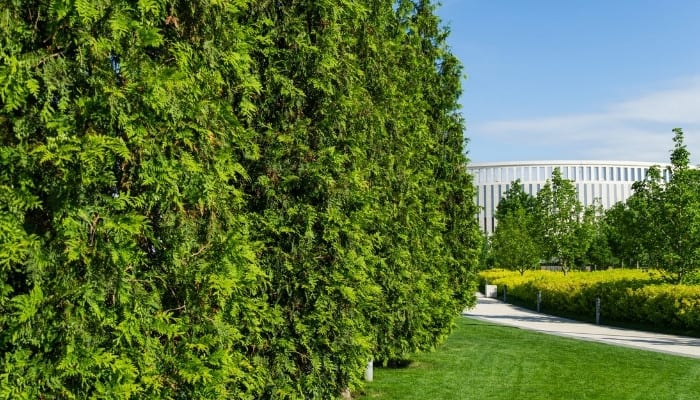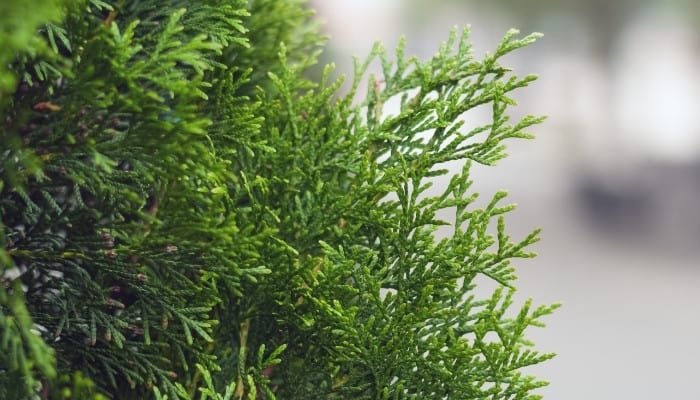Will Thuja Green Giants hold up over time on a property with frequent deer visitors, considering their ability to thrive as stunning individual evergreens or well-groomed hedgerows that require little upkeep?
Will deer eat Thuja ‘Green Giant’? Thanks to its red cedar genes, Thuja Green Giant is as deer resistant as trees may be. However, a hungry deer that has no other dietary options may eat a Green Giant, but starving deer would most likely eat other species from your yard before they resorted to munching Thuja.
In the following, you’ll find more information on Green Giant’s ability to keep deer at bay and tips for keeping your Thuja trees looking their absolute best.
Thuja Green Giant and Deer
Green Giants and deer are not friends. Thuja shares a genetic makeup with Western red cedar, a species that deer find practically inedible, which makes them extremely resistant to deer and similar pests.
Below, we discuss the relationship between Thuja and deer in greater detail, section by section:
Deer Resistance
Thuja has a higher resistance to deer than most trees do, making them an ideal candidate for landscaping purposes.
Because of their cedar-type genes, deer won’t come near them unless they are completely starved and need a food source desperately.
Why Deer Avoid Thuja Green Giant
Deer avoid Thuja Green Giants because there are typically far more appealing and readily available food sources to choose from.
A deer is more likely to eat a bush or garden plant before it would take a bite out of your Green Giant.
Additionally, the red cedar background of Thuja also keeps the deer and other arborvitae-eating pests away.
When Deer May Target Thuja Green Giant
The most common time for deer to even think about eating Thuja Green Giants is in the deepest, coldest parts of winter when other food sources are extremely scarce.
When most of their food sources are covered in snow or waterlogged, thanks to snow and ice melt, deer are at their most desperate and may feed on Thuja and other arborvitaes they’d otherwise avoid.
Will Deer-Damaged Green Giant Arborvitae Grow Back?
Depending on how much damage the deer actually inflict on your Thuja Green Giants, those areas may or may not grow back.
If the branches have been eaten entirely bare, they will more than likely not grow back.
The parts of your Green Giants that are damaged by deer should be trimmed lightly or in some cases pruned back entirely to encourage new growth.
A general-purpose fertilizer should also be applied when repairing deer-damaged Green Giants.
General Care for Thuja Green Giant

Green Giants are one of the easiest evergreen species to care for. There are a few simple guidelines to follow for proper Thuja Green Giant care and maintenance.
Soil and Fertilization
Thuja Green Giant grows well in just about any type of soil you can imagine. That said, if you are looking for a fast growth rate, they prefer acidic soil.
As far as fertilizer is concerned, Thuja doesn’t necessarily need any.
However, like most self-reliant plants, they still benefit from a dosage of general-purpose fertilizer (10-10-10 or 14-14-14) once per year.
I recommend this large bag – great price, quality product, and clear directions – it doesn’t get much better than that.
Watering
The soil of your Thuja Green Giants should remain moist in between waterings, but it should never soaked to the point of being soggy.
New Green Giants need watering every 2 to 3 days, while older specimens only need watering every 2 weeks or so (especially if mulched).
Lighting
As long as your Green Giants receive a minimum of 4 hours of direct sunlight or 6 to 8 hours of indirect sunlight, they will grow and thrive.
If planted somewhere that receives less light, they may survive, but their growth rate will be much slower.
Pruning
Thuja Green Giants are one of the few species that make excellent hedgerows but don’t require regular pruning. In fact, after your hedges are shaped you don’t have to prune them ever again.
A light trimming session once per year is more than enough to keep Green Giants looking nice and neat. Some folks go years without trimming their Thuja hedges.
Other Deer-Resistant Arborvitae
Unfortunately, there aren’t too many other deer-resistant arborvitae out there to choose from, which makes Thuja Green Giants an even more impressive choice for your yard or new hedgerow.
The most well-known deer-resistant arborvitae (other than Thuja Green Giant) include:
- Steeplechase
- Spring Grove
- Zebrina
- Hybrid varieties of Western arborvitae
- Hybrid varieties of Giant arborvitae
Related Questions:
What Is the Difference Between Green Giant and Emerald Green Arborvitae?
There is very little difference in the shape, size, and growth rate of Green Giants and Emerald Greens.
The main difference between the two species is in their color; Green Giants are darker green and sometimes bronze, while Emerald Greens are much lighter (especially in the sunlight).
Emerald Green also lacks the cedar-type genes that make Green Giant deer resistant.
Will Deer Eat Emerald Green Arborvitae?
Deer are known to eat Emerald Green Arborvitae, which makes Thuja Green Giants a much more reasonable choice for most landscaping purposes.
A Final Word About Deer and Thuja Green Giants
Thuja Green Giants are among the top choices of evergreens for landscaping.
They grow any size or shape you want (within reason), they are super easy to maintain, and most pests wouldn’t touch them with a 10-foot pole, including deer.
They may not be completely deer resistant, but compared to other evergreen trees and species that make nice hedges, Thuja Green Giants truly stand tall.
And, since they are quite a deer-resistant sort, they’ll remain standing longer than other species!

